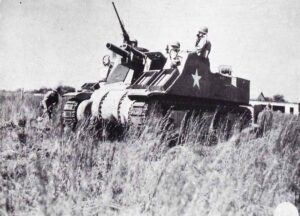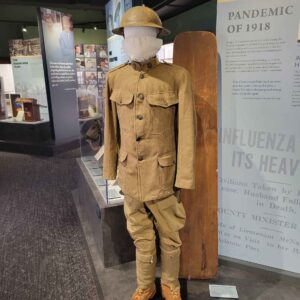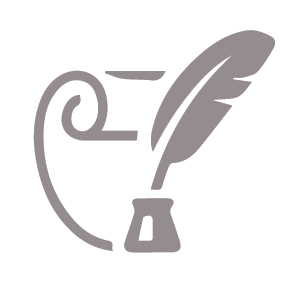The Fort Jackson Museum Community (FJMC) at Fort Jackson, South Carolina, consists of four museums: the Fort Jackson, U.S. Army Chaplain, U.S. Army Adjutant General Corps, and U.S. Army Finance Corps Museums. In addition to telling the story of Fort Jackson and the training of soldiers, the FJMC also interprets the history of the Army’s three smallest branches.
The Fort Jackson Museum first opened in 1974 in a building originally constructed in 1941 as a recreation hall and later serving as a post exchange. Although the overall mission of the museum is to tell the history of the Army and training, the museum focuses on the history of Fort Jackson from its opening in 1917 to the present.
Exhibits near the entrance of the museum include examples of uniforms from the Revolutionary, Civil, Indian, and Spanish-American Wars, and a bust of Andrew Jackson, the fort’s namesake, donated by the citizens of Columbia, South Carolina. Other exhibits focus on the early days of the fort, its construction, and its use as a training center for soldiers during World War I. Displays include photos of Fort Jackson, various examples of weapons and equipment, the regimental colors of the 371st Infantry, a regiment that formed part of the all-black 93d Diorama, and a replica of a post stable. One interesting display describes the development of the first shoulder sleeve insignia, the black “Wildcat” patch of the 81st Division, which trained at Fort Jackson before deploying to France in 1918.
As in World War I, Fort Jackson trained thousands of soldiers during World War II. The museum’s World War II gallery lists the divisions that trained there and includes division shoulder patches, various examples of U.S. and foreign equipment and weapons, photographs, unit newspapers, and maps. The gallery also contains a replica of a World War II-era barracks, a period truck, and a display of an Army tradition that many veterans can relate to-KP duty.
The Medal of Honor Hall, which is used for large groups, educational programs, and films, honors seventeen soldiers from South Carolina who earned the Medal of Honor. The hall includes Medal citations and photographs.
The Korean War gallery features a vast array of weapons and equipment used during the war, along with uniforms, photos, and a diorama of the Battle of Chipyong-ni. The gallery also includes a display honoring South Carolina soldier PFC Noah O. Knight, a soldier from Company F, 7th Infantry, 3d Infantry Division, who earned the Medal of Honor posthumously in November 1951.
A major component of the museum is the gallery dedicated to the U.S. Army Drill Sergeant School, which opened at Fort Jackson in 1964. The gallery describes the history of drill sergeants and the history and symbolism of the Drill Sergeant Badge, and includes uniforms, photos, insignia, and NCO chevrons.
The museum features a large Vietnam War gallery with photos, weapons, and uniforms. One highlight of the gallery is a recreation of Bau Bang (Bad News) Village, a replica of a Vietnamese hamlet constructed at Fort Jackson in 1966 for soldiers going through Advanced Individual Training who were to deploy to Southeast Asia.
More recent conflicts, such as Desert Shield/Storm conclude the indoor exhibits. Artifacts in this section include uniforms, chemical-biological-nuclear equipment, and MREs, along with photographs and maps.
Outdoor exhibits located around the museum include memorial unit plaques and various vehicles, tanks, and artillery pieces. Several other large artifacts, such as tanks, can be found at other locations around post, including the reception center and the U.S. Army Soldier Support Institute.
A great feature of the museum is a set of free handouts about Fort Jackson and general Army history available to visitors. The Fort Jackson Museum, which receives approximately 25,000 visitors annually, also has a research library available by appointment.
The U.S. Army Chaplain Museum first opened at Fort Slocum, New York, in 1958 and was later located (with the U.S. Army Chaplain Center and School) at Fort Hamilton, New York; Fort Wadsworth, New York; and Fort Monmouth, New Jersey, before arriving at Fort Jackson in 1996. The current Chaplain Museum is located on the lower level of the Chaplain Center and School.
The U.S. Army Chaplain Museum tells the story of the U.S. Army Chaplain Corps from its birth on 29 July 1775 to the present, but it also briefly touches on the origins of military chaplains from early history and the service of chaplains with colonial militias. Exhibits detail the early history of the Chaplain Corps, including the commissioning of John Hurt, the first chaplain commissioned in the Army in 1791, the reinstatement of the Chaplain Corps in 1838, and the commissioning of the first Catholic chaplains during the Mexican War.
The museum features an extensive exhibit area on Civil War chaplains, both Union and Confederate. The displays in this section discuss the first Jewish and African American chaplains in the Army, and the three chaplains-John M. Whitehead, Francis B. Hall, and Milton Haney–who earned the Medal of Honor during the Civil War. Also on display are a number of photographs and chaplain’s frock coat. Nearby are exhibits on chaplains who served with the Army in the West and during the Spanish-American War.
The next major exhibit area covers chaplains in World War I. In addition to a replica of a World War I field hospital, the World War I exhibits include a large display on Father Francis P. Duffy, who served with the 165th Infantry (“Fighting 69th”), 42d Division, and features photos and Father Duffy’s chalice and vestment set.
Exhibits on the interwar years focus on the development of the Chaplain School and the creation of the position of Chief of Chaplains. Also included in this section is information about Army chaplains serving with the Civilian Conservation Corps during the Great Depression.
The World War II gallery, the largest section of the Chaplain Museum, includes exhibits on the addition of chaplain assistants and the heroic Four Chaplains, who died saving others during the sinking of the troopship SS Dorchester in February 1943. Other exhibits feature dozens of photos and chaplain related artifacts. The most prominent artifact in the World War II gallery is the Finschhafen Altar, built by the soldiers of the 9th Ordnance Battalion for their chapel in New Guinea. The altar was constructed out of whatever was available to the soldiers and includes brass shell casings, parachute cloth, bicycle chains, and other material. A particular interesting display discusses the Army chaplains who administered to the former Nazi leaders who were tried at Nuremburg.
The Korean War exhibits include a replica of field service with a makeshift altar, and the vestments worn by Father Emil Kapaun, a Catholic chaplain who served with 8th Cavalry and later died in a Communist POW camp. Nearby is an extensive collection of chaplain kits used by Christian, Jewish, and Muslim chaplains.
A display on Chaplain Charles J. Watters, who served with the 173d Airborne Brigade and earned the Medal of Honor posthumously during the fighting at Dak To in November 1967, highlights the Vietnam War section of the museum and features photographs and the remains of Watters’ chaplain kit. Also featured are photos of chaplains serving in Vietnam.
Since music plays an important part in religious services, the museum features a collection of musical instruments used by chaplains and chaplain assistants, along with hymnals and an example of a Broadman hymn player, an electronic music device that can play 600 hymns and other songs.
The final exhibits detail more recent developments within the Chaplain Corps, including the commissioning of the first female chaplain, Alice M. Henderson, in July 1974, the development of the Unit Ministry Team concept, chaplains in Desert Shield/Storm, and a menorah used at a December 2001 Hanukkah service held at Ground Zero, New York City. In addition to exhibits, the U.S. Army Chaplain Museum also features a research library available by appointment
The U.S. Army Adjutant General Corps Museum, co-located with the U.S. Army Finance Corps Museum in a former movie theater, was first authorized in December 1996 to collect and display artifacts of one of the Army’s oldest branches. The museum opens with displays of the Army’s early adjutants (the Army’s first staff officer position), including MG Horatio Gates, the hero of Saratoga. Artifacts include the tools of the trade of the early adjutants, including printing equipment, paper, and quill pens. Other prominent Army officers who served as the Adjutant General included Alexander Macomb (1812), who later became the Army’s commanding general, and Zebulon Pike (1812-1813), Army explorer for whom Pike’s Peak is named.
Other prominent Adjutants General featured in the museum include BG Lorenzo Thomas, who served in his post from 1862-1869, and BG Edward D. Townsend, who served from 1869-1880. Townsend served as the Assistant Adjutant General during the Civil War and probably saw President Abraham Lincoln during the administration than any other person. Townsend later collected much of the data that became The War of the Rebellion: A Compilation of the Unofficial Records of the Union and Confederate Armies, the indispensable source of information for Civil War scholars. The museum’s collection includes Townsend’s epaulets, donated to the Army by his family in 1971.
Typewriters have played a key role in the Adjutant General Corps’ mission of Army administration, so accordingly, the museum has an extensive collection of typewriters, including the first examples acquired by the Army in 1880s, to standardized and more compact models used in World Wars I and II. The most also has displays of the Army’s first computers, developed in World War II, the development of machine records units, and various types of computer hardware and software.
A key mission of the Adjutant General Corps since World War I is postal operations, including dispatch service. One highlight of this section of the museum is a restored 1941 Harley-Davidson WLA motorcycle used by Army couriers.
Another mission of the Adjutant General Corps prominently covered at the museum is Army morale and music. This section of the museum features artifacts and photographs relating to recreation and sports, entertainment such as Bob Hope holidays shows and other performances by Army Special Service units, and music, especially Army bands. Future plans call for additional exhibit space on the history of Army bands.
The museum concludes with an exhibit on the 11 September 2001 terrorist attack on the Pentagon. The exhibit includes the dress blue uniform that once belonged to LTG Timothy G. Maude, the Deputy Chief of Staff for Personnel (DCSPER) on 11 September, who was killed in the attack, along with artifacts recovered from the rubble around LTG Maude’s office.
The U.S. Army Finance Corps, located adjacent to the Adjutant General Corps Museum, was founded on 29 January 1954 at Fort Benjamin Harrison in Indianapolis, Indiana, and remained there until it moved to Fort Jackson in 1996. The mission of the museum is to tell the history of the U.S. Army Finance Corps from its inception in 1775 to the present.
The museum’s collections include the largest collection of military pay certificates in the world, and displays of military currency play a major role in the exhibits. One thing visitors will find interesting are charts posted throughout the museum that list the pay of soldiers throughout various periods of Army history.
The Civil War exhibits discuss the difference between Union and Confederate pay systems (Union soldiers were paid by a paymaster, Confederates by a quartermaster) and the hazards of the paymaster’s job, as they were constantly the target of Confederate raiders. The displays also feature examples of Civil War era currency.
The Spanish-American War exhibit includes a newly acquired paymaster’s jacket, along with a pay bag, currency, and a paymaster manual. Nearby are displays on World War I that include uniforms and equipment, and information on the establishment of an independent Finance Department as the result of the National Defense Act of 1920. (The Finance Department was redesignated the Finance Corps in 1956.)
The World War II exhibit area features examples of Allied military currency and a display on MAJ Robert C. Davie of the 136th Finance Detachment, who arrived on Omaha beach on 6 June 1944, approximately eight hours after the initial D-Day landings. Displays on the Finance Corps in the Korean War include photographs and examples of military currency.
Exhibits in the Vietnam War section of the museum include examples of the first Military Payment Certificates, photographs, and a Viet Cong 122mm rocket, symbolizing the fact that Finance Corps soldiers were targets like all other servicemen in Vietnam. The final wartime exhibits focus on Operations Desert Shield/Storm and Iraqi Freedom and include photographs, counterfeit currency recovered from Iraq, and copper and zinc bars found in Iraq that were originally thought to be gold.
The museum concludes with artifacts and photographs of the former U.S. Army Finance Center at Fort Benjamin Harrison and a display on LTC Lewis L. Hawkins, a Finance Corps officer who was assassinated in Tehran, Iran, in 1973. The Lewis L. Hawkins Award is awarded to the Finance Corps officer who demonstrates the greatest level of professionalism in the eyes of his peers and team leaders.
Making a Visit: The Fort Jackson Museum is located 4442 Jackson Boulevard across from post headquarters. The museum hours are 0900-1600, Monday-Friday, closed weekends and federal holidays. For more information, view the museum website at www.jackson.army.mil/Museum/Index.htm, or call (803) 751-7419. The U.S. Army Chaplain Museum is located at 10100 Lee Road, Fort Jackson, SC. The museum is open Monday-Friday, 0900-1600, and closed weekends and federal holidays. For more information, visit the museum website at www.usachcs.army.mil/museum/nav1/mainpage.html, or call (803) 751-8079. The U.S. Army Adjutant General Corps Museum and U.S. Army Finance Corps Museums are located at 4392 Magruder Avenue, Fort Jackson, SC. The museums are open Tuesday-Friday, 1000-1600, and closed on weekends and federal holidays. For more information on the Adjutant General Corps Museum, call (803) 751-1747, or e-mail Ms. Darcie Fouste, museum director, at Darcie.fouste@jackson.army.mil. For more information on the Finance Corps Museum, call (803) 751-3771, or e-mail Mr. Henry Howe, museum director, at henry.howe@jackson.army.mil. Admission and parking are free for all four FJMC museums; donations are welcome.



